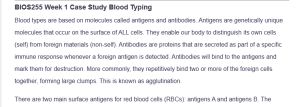BIOS255 Week 1 Case Study Blood Typing
Antigens and Antibodies Present in Each Blood Type
Each blood type has different antibodies and antigens. Notably, the red blood cells (RBCs) of individuals with blood type A have A antigens and anti-B antibodies in the plasma. Conversely, blood type B has B antigens on RBCs and anti-A antibodies in the plasma (Abegaz, 2021). People with type AB have both A and B antigens on RBCs. They have no anti-A or anti-B antibodies in plasma. Those with type O have anti-A and anti-B antibodies in their plasma. They have no A or B antigens on RBCs; therefore, they are the universal donors. Rh antigen is present in Rh+ blood and absent in Rh- blood, which affects transfusion compatibility.
How the Agglutination Reaction Is Used to Determine Blood Type
Using antibodies against A, B, and Rh antigens with a blood sample determines blood type (Li & Guo, 2022). Agglutination means the antigen is present. Agglutination with anti-A and anti-Rh but not anti-B means A+ blood. No agglutination means the antigen is absent.
The Blood Type Considered the Universal Recipient and the One Regarded as the Universal Donor
Universal recipients are AB+ because they have A and B antigens and no anti-A or anti-B antibodies. Therefore, they can receive any blood type. Conversely, universal donors are O- because they have no A, B, or Rh antigens. The risk of immune reaction in recipients is, therefore, reduced.
Emily Could Donate Blood to Individuals with Which Blood Type
Emily is A-positive. She can give blood to individuals who have A-positive and AB-positive blood types. These recipients can receive her A antigen and Rh-positive blood without adverse reactions.
Can Emily Receive Blood from A Rh-Negative Donor if a Transfusion is Required? Why or Why Not?
If a transfusion is needed, Emily can get blood from a Rh-negative donor. Emily is Rh positive. This means her body already has the Rh antigen. Therefore, her body will not react to Rh-negative blood, which does not have the antigen. She can safely get Rh-negative blood because it has no new antigens that can trigger an immune response. People with blood type A positive, A negative, O positive, and O negative can give to Emily. In this case, her being Rh-positive allows her to get blood from Rh-positive and Rh-negative donors, which is good because Rh compatibility is key.
References
Abegaz, S. B. (2021). Human ABO blood groups and their associations with different diseases. BioMed research international, 2021(1), 6629060. https://doi.org/10.1155/2021/6629060
Li, H., & Guo, K. (2022). Blood group testing. Frontiers in Medicine, 9, 827619. https://doi.org/10.3389/fmed.2022.827619
ORDER A PLAGIARISM-FREE PAPER HERE
We’ll write everything from scratch
Question
BIOS255 Week 1 Case Study Blood Typing
Blood types are based on molecules called antigens and antibodies. Antigens are genetically unique molecules that occur on the surface of ALL cells. They enable our body to distinguish its own cells (self) from foreign materials (non-self). Antibodies are proteins that are secreted as part of a specific immune response whenever a foreign antigen is detected. Antibodies will bind to the antigens and mark them for destruction. More commonly, they repetitively bind two or more of the foreign cells together, forming large clumps. This is known as agglutination.

BIOS255 Week 1 Case Study Blood Typing
There are two main surface antigens for red blood cells (RBCs): antigens A and antigens B. The presence or absence of these antigens will specify your blood type. Antibodies are present in blood plasma and are specific to antigens that are not present on your own red blood cells. In simpler terms, you have antibodies opposite of the antigens you have.
Background:
Emily Johnson, a 25-year-old laboratory technician, comes to the laboratory for her routine blood typing. She is preparing for a surgical procedure and needs to know her blood type. Emily has no significant medical history and has never undergone any blood transfusions.
Desired Outcomes:
- Determine Emily’s ABO blood group and Rh factor.
- Educate Emily about the significance of blood typing and the potential risks associated with mismatched blood transfusions.
- Provide appropriate recommendations based on Emily’s blood type.
Findings:
Emily’s blood sample is tested for ABO blood group and Rh factor. Results indicate that Emily’s blood type is Antigen-A positive and Rh-positive.
Questions:
- Describe the antigens and antibodies present in each blood type.
- Explain how the agglutination reaction is used to determine blood type.
- Which blood type is considered the universal recipient, and which is considered the universal donor? Why?
- Emily could donate blood to individuals with which blood type?
- Can Emily receive blood from an Rh-negative donor in the event that a transfusion is required? Why or why not?

